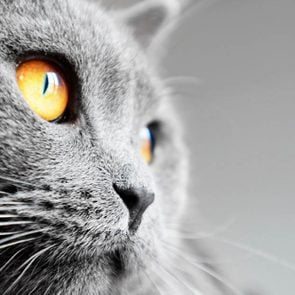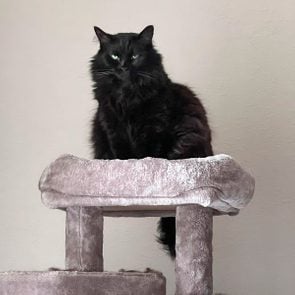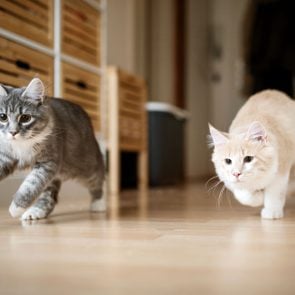Why Do Cats Purr? 7 Reasons for This Sweet Kitty Sound
Updated: Apr. 13, 2024
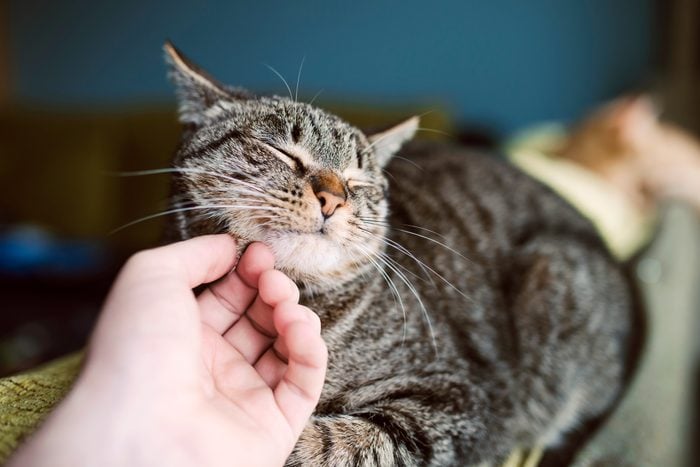
Cats purr to communicate with you. The trick is figuring out what they're trying to say.
To a cat lover, it’s the most beautiful sound in the world. A cat’s purr—that soft rumble emanating from your favorite feline when he’s curled up in your lap and you’re rubbing juuust the right spot—feels like the sound of pure bliss. But why do cats purr, and what does that sound really mean? Is it simply the sign of a happy cat? Or is there more to it than that?
As with most questions about cat behavior—like why cats meow and why cats chirp—the answer isn’t always easy to pin down. In fact, researchers still aren’t sure they understand the mechanics of exactly how cats physically produce that velvety vibrato, much less the bigger question of why cats purr. But they do have some theories. Here’s what we found out.
Get Reader’s Digest’s Read Up newsletter for more pet insights, humor, cleaning, travel, tech and fun facts all week long.
Why do cats purr?
“For cats, purring is a way of communicating,” says Susan Whittred, DVM, a veterinarian in Oyster Bay, New York. “It’s how they show emotion. And while it usually means they’re happy, it could mean almost any emotion—happy or sad.”
That doesn’t make it easy for cat parents to figure out what their furballs are trying to tell them, but, well, that’s cats. “Cats are pretty mysterious to begin with, and with purring, I think they’re going to keep it that way,” says Dr. Whittred. “We may never know all the reasons for the things they do.” Still, experts have pinned down some of the reasons a cat might break out in a purr.
They’re happy
This is by far the most likely reason for your kitty’s purring. “Most of the time when you hear a cat purr, it’s a positive thing,” says Vered Bar, VMD, a San Francisco–based veterinarian. “It’s something cats do when they’re happy and content.”
If you want to be sure, check out your cat’s body language. Are his ears forward? Is his face relaxed? “If you want to know what the cat is trying to communicate, you have to put the purr in context,” explains Dr. Whittred. “So if you have a cat that’s relaxed and making biscuits with his front paws, that’s obviously a really happy purr.”
They like what you’re doing
If you’re petting your cat and he’s purring and you suddenly get to a spot where that soft vibration revs up into a jet-engine roar, you know you’re doing something right. “That purring is a way for the cat to communicate that they’re liking what you’re doing,” says Kara Nelsen, DVM, a veterinarian in Minneapolis. “When you’ve got a cat on your lap and you’re petting him, he’s going to purr to let you know to keep going.”
They’re saying hello
Sometimes all you have to do is walk in the house and your cat will start purring. “It’s just another form of greeting,” says Dr. Nelsen. “[It’s similar to] the way they will rub against your leg when they want attention.” Essentially, they’re just happy to have you home, and they’re purring to let you know it.
They want something
Along with other types of cat vocalizing, cats can also use their purr to communicate to their humans when they want something. “Sometimes they’re just trying to express something, like they want attention or they’re hungry,” says Dr. Nelsen. A study published by researchers at the University of Sussex in 2009 even found that some cats can modulate the frequency of their purr—adding a higher-pitched cry sound to it—to subtly trigger a sense of urgency when they want to be fed. (Humans seem to have a nurturing instinct that responds to the higher-pitched sound.) This so-called “solicitation purr” lets them disguise their “feed-me” demands as purrs.
They’re speaking in kitty code
Kittens learn everything they know about being a cat from their mothers, including how to communicate with other cats. Mama cats often purr while nursing their kittens, which gives little ones a sense of comfort even before they are old enough to open their eyes. And the kittens reciprocate this communication cue quickly. “Kittens start purring at two days old to say hi to their mom,” says Dr. Whittred. “And they use purrs to signal to each other.” As kittens grow, they also use purrs to indicate that they’re hungry or lonely, and they eventually purr when content, just like mom.
They’re stressed out
Purring doesn’t always equal happiness—it can also mean that a cat is anxious. “Sometimes at the hospital, we see cats who are very nervous purring, and you can tell that they’re not purring because they’re happy but because they’re nervous,” says Dr. Bar. “We think the purring is actually a method of self-soothing. I don’t think we have enough research to say if purring releases endorphins, but there is a thought that perhaps they do it as a way of telling themselves that everything is OK.”
They’re in pain or ill
Cats that are very ill or even dying have also been known to purr. “As an emergency veterinarian, I see a lot of cats that are not in a great situation, and I have seen cats that are purring when they’re essentially near death or in significant pain,” says Dr. Nelsen. “We don’t know if it actually helps them feel better or if they’re just somehow trying to comfort themselves.”
How do cats purr?
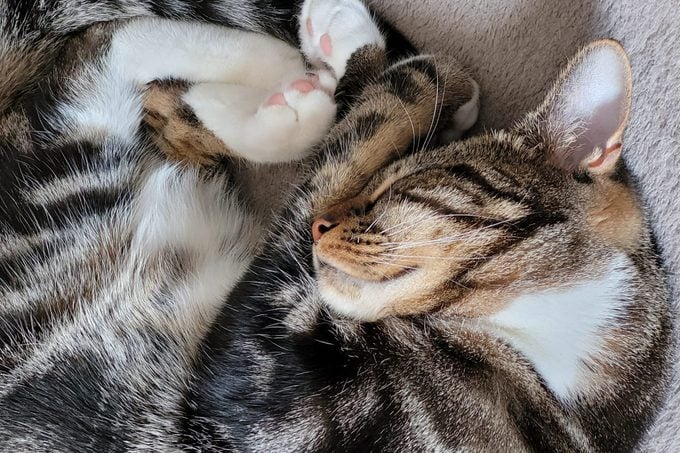
Now that you know why cats purr, you might be wondering how they do it, exactly. Scientists have long held a pretty straightforward theory about how purring works. “Essentially, the brain initiates the purr, and then the muscles of the larynx and diaphragm oscillate back and forth, which causes a vibration to come out of the glottis (the opening between the vocal cords) and create the purring sound,” says Dr. Whittred. But a brand-new study, published in the journal Current Biology in November 2023, challenges traditional thinking by suggesting that the larynges of cats can produce purring sounds without continued neural input or muscular contraction. Because of fibrous pads on a cat’s vocal cords, says Austrian voice scientist Christian T. Herbst, a purr can be produced simply by passing air through the vocal cords, making it more like a snore than a conscious action.
While the discovery made headlines, the question is far from resolved. “The study was conducted on larynges that were outside the cats’ bodies,” says Dr. Bar. (The study used the larynges of cats that had been euthanized after being diagnosed with terminal illnesses.) “It’s hard to say that’s how it happens when it’s inside their bodies. Purring does seem connected to how a cat is feeling. The sound is from the vibrations, but whether it’s them consciously doing it or whether it’s something that just happens, I don’t think we know.”
Why does my cat purr a lot?
If your cat is a nonstop purrer, you might think it’s because he’s just a really, really happy cat. And he might be! But it also might simply be a quirk of his personality. “Just like some people are more talkative than others, some cats are more talkative and tend to purr more,” says Dr. Nelsen.
It may also have something to do with your cat’s genetic background. “In the same way that some cat breeds, like Siamese, are more vocal and talkative, other breeds, like Maine coons, tend to be more quiet,” says Dr. Bar. “It’s possible it developed the same way with purring.”
Should I be concerned if my cat doesn’t purr?
Not necessarily. Your cat might just be the strong, silent type. “Some cats are just more emotive than others,” says Dr. Bar. “Ones that purr a lot are just very good at expressing how they feel, and ones that purr less are just a little bit more reserved.”
It may also be that your cat is purring and you just can’t hear it. “With some cats, their purr might not be as audible,” says Dr. Whittred. “They probably are purring but at a lower volume, and we just don’t hear them. Sometimes you can feel the vibration but not actually hear the noise.”
But if you have a cat that purrs all the time and suddenly stops purring, that should be a cause for concern and a sign you should take your cat to the vet. “If your cat normally purrs and suddenly you’re not hearing that anymore, or the purr sounds different, like if it’s crackly or deeper, then as a veterinarian I might be concerned,” says Dr. Nelsen. “It’s possible that something has changed in the throat of the cat—that there might be something stuck back there or a growth in the voice box.”
Is purring good for cats?
While many vets believe cats use purring as a means of self-soothing when they’re afraid or not feeling well, there are some who theorize it might be physically healing as well. A study published in the New Zealand Veterinary Journal in 2001 analyzed the purrs of domestic cats, cheetahs, pumas, ocelots and servals, and found that the frequencies of the purrs (between 25 Hz and 150 Hz) matched frequencies used to promote bone growth and heal soft tissue. “There may be therapeutic benefits from the vibrations,” says Dr. Whittred. “We just don’t know yet.”
How does cat purring affect humans?
It’s no secret that owning a cat can be good for you. Studies have shown that cat (and dog) owners have a lower risk of stroke and other cardiovascular diseases. Some of that may be just the benefits of animal companionship, but listening to your cat’s purrs may play a part in it too. “Having a cat has been shown to lower our blood pressure, our heart rate, and I think purring has a lot to do with it,” says Dr. Whittred. “It’s soothing.”
About the experts
- Vered Bar, VMD, MLAS, is chief of service veterinarian for primary care at the San Francisco Animal Medical Center.
- Kara Nelsen, DVM, MPH, is the founder of Allied Emergency Veterinary Service, which operates three emergency animal hospitals in Minnesota and Wisconsin.
- Susan Whittred, DVM, is executive director of the Patricia Ladew Foundation, a nonprofit based in Oyster Bay, New York, that’s dedicated to providing sanctuary, medical treatment and adoption services for homeless cats.
Sources:
- Current Biology: “The cry embedded within the purr”
- Current Biology: “Domestic cat larynges can produce purring frequencies without neural input”
- The Journal of the Acoustical Society of America: “The felid purr: A healing mechanism?”
- Journal of Vascular and Interventional Neurology: “Cat ownership and the Risk of Fatal Cardiovascular Diseases. Results from the Second National Health and Nutrition Examination Study Mortality Follow-up Study.”
- Psychology and Behavioral Science: “The Benefits of Pets for Human Health”

